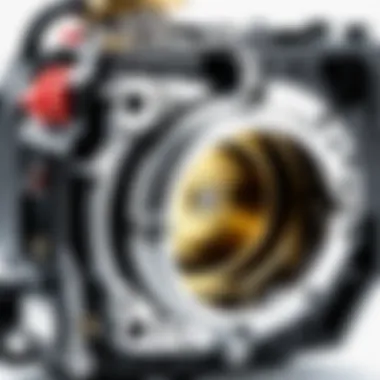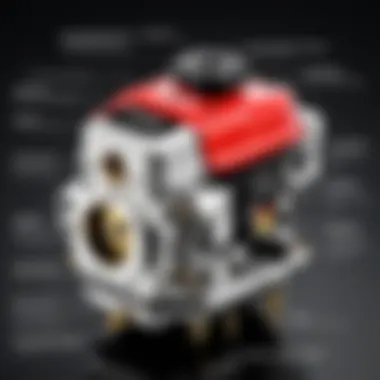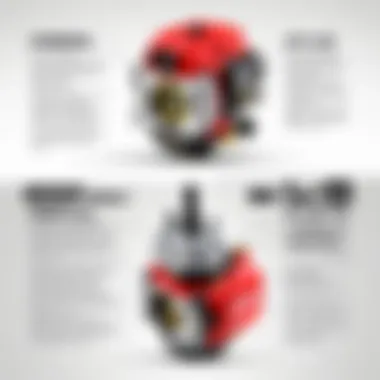Comprehensive Guide to Shindaiwa Trimmer Carburetors


Intro
Understanding the intricacies of the Shindaiwa trimmer carburetor is essential for anyone looking to maximize the performance of their trimmer. The carburetor plays a crucial role in mixing air and fuel to ensure efficient combustion. An informed user knows how to maintain and troubleshoot this part effectively. A well-performing carburetor not only boosts the trimmer's efficiency but also extends its lifespan. In this overview, we will dive deep into the technical specifications, practical applications, latest trends, and more, presenting a guide for optimal usage.
Technical Specifications
Detailed Product Specs
The Shindaiwa trimmer carburetor varies across models, but they typically share several key specifications. Most models feature a diaphragm carburetor design, which ensures smooth operation under various conditions. The common fuel intake sizes generally fall between 20 mm and 25 mm, depending on the specific model. Engine compatibility is usually paramount, with most carburetors supporting Shindaiwa engines ranging from 21.2 cc to 30.5 cc.
Performance Metrics
Performance metrics are essential for evaluating the effectiveness of a carburetor in a trimmer. Fuel efficiency often measures how well a carburetor blends the air and fuel mixture. A well-tuned Shindaiwa carburetor can maintain an average fuel consumption of around 600-700 ml per hour, depending on the model and usage conditions. Additionally, power output can also be assessed, with many Shindaiwa models providing around 1.0 to 1.5 kW.
Compatibility Information
When replacing or purchasing a new carburetor, compatibility is key to ensuring seamless performance. Most Shindaiwa carburetors are designed to fit specific models like the Shindaiwa T242, T260, and T275. It is crucial to refer to the owner’s manual or manufacturer recommendations to avoid any misalignments or performance issues.
Practical Applications
Use Cases for Different Users
The Shindaiwa trimmer carburetor serves a variety of users. For landscapers, the trimmer equipped with an efficient carburetor allows for long hours of operation without frequent refueling, improving productivity. Homeowners can benefit from easier maintenance and reliable performance for regular lawn care. Garden enthusiasts find it essential for precise trimming tasks.
Recommended Configurations
Optimal configurations for trimmers often depend on the intended use. For heavy-duty tasks, it is advisable to use a carburetor with enhanced fuel tuning capabilities, allowing for better power delivery under load. For light trimming, a standard configuration suffices.
Multi-Platform Performances
Shindaiwa carburetors are designed to perform across multiple platforms efficiently. The versatility allows users to adapt the trimmer for various tasks—from residential maintenance to professional landscaping—ensuring that performance remains consistent regardless of the environment.
Latest Trends
Industry Developments
Recent shifts in the landscaping industry indicate a growing emphasis on fuel efficiency and emission standards. Manufacturers, including Shindaiwa, are adapting their products to meet these regulations. Innovations in carburetor designs focus on better air-fuel mixing techniques.
Emerging Technologies
Emerging technologies such as electronic fuel injection (EFI) are becoming more prevalent. While traditional carburetors still dominate, many consumers are looking towards EFI solutions for superior efficiency and lower emissions.
Future Predictions
The future of carburetlors in trimmers points towards a blend of traditional and electronic systems, providing users with choices that align with their operational preferences. As regulations tighten, manufacturers will likely innovate further, shaping the trimmer landscape over the coming years.
Buying Guides
Recommended Products
For those considering a purchase, several carburetors stand out. Models like the Shindaiwa A2020 and the Shindaiwa A2650 are recommended due to their performance metrics and user satisfaction ratings.
Purchasing Tips
When buying a replacement carburetor, always check for OEM parts to ensure compatibility and reliability. Additionally, consider purchasing through authorized dealers or retailers to benefit from warranty support.
Warranty and Support Information
Most Shindaiwa carburetors come with a limited warranty, typically ranging from one to two years. Understanding the warranty terms is essential for effective maintenance. Support is readily available through Shindaiwa’s official service centers and customer support channels.
"A well-maintained carburetor is vital for the performance and longevity of your trimmer."
By understanding these facets of the Shindaiwa trimmer carburetor, users can optimize performance and extend the life of their equipment.


Understanding the Trimmer Carburetor
The trimmer carburetor plays a vital role in the overall performance of Shindaiwa trimmers. Understanding its functions, components, and maintenance needs helps users to achieve optimal operation. A well-functioning carburetor ensures that the engine runs smoothly and efficiently. When problems arise, they can lead to decreased performance, higher fuel consumption, and even engine damage.
Function of a Carburetor in Trimmers
The carburetor is responsible for mixing air and fuel in the correct ratios before it reaches the engine. This mixture is crucial for combustion, which powers the trimmer. An accurate mixture enhances engine efficiency, allowing for quick starts and consistent power output. Carburetors can affect not only performance but also the longevity of the engine. If the mixture is too rich or too lean, it can lead to issues such as fouled spark plugs or overheating.
Key Components of a Carburetor
Float Chamber
The float chamber is an essential component of the carburetor. It regulates the fuel level, ensuring a steady supply for the engine. Its primary characteristic is that it automatically adjusts the fuel level through a float mechanism. This feature prevents overflow and ensures that the carburetor receives the proper amount of fuel. A well-designed float chamber contributes to overall efficiency by maintaining the right fuel level.
Venturi
The venturi is a critical part of the carburetor that plays a significant role in the fuel-air mixture process. As air passes through the venturi, its velocity increases and pressure decreases, drawing fuel into the airstream. This function is vital for proper atomization of fuel, which promotes efficient combustion. A key advantage of the venturi is its ability to self-adjust based on airflow, but improper size can lead to either poor performance or flooding.
Throttle Valve
The throttle valve controls the amount of air entering the carburetor, which directly affects engine power and speed. It is critical for regulating engine performance during operation. A notable characteristic of the throttle valve is its responsiveness. Proper adjustment can lead to smoother acceleration and better control while trimming. However, a malfunctioning throttle can cause erratic engine behavior or stalling, making it a reliable balance that must be maintained.
Idle Adjustment Screw
The idle adjustment screw is a crucial component for setting the engine's idle speed. It helps in fine-tuning the air-fuel mixture when the engine is not under load. Its primary characteristic is its impact on the smoothness of the engine idle. A correctly set idle prevents stalling and ensures that the engine starts easily. However, if not properly adjusted, it can lead to rough idling or excessive fuel consumption, making it essential for careful calibration.
"Understanding the trimmer carburetor is fundamental for ensuring optimal performance and longevity of any Shindaiwa trimmer."
Overview of Shindaiwa Trimmer Models
Understanding the various Shindaiwa trimmer models is essential for users and potential buyers. Each model is engineered with specific features that cater to distinct trimming needs. Knowing the models can provide clarity on performance, reliability, and maintenance needs. Furthermore, a thorough awareness can influence the decision-making process for those looking to purchase a trimmer that aligns with their requirements.
Popular Shindaiwa Models
T242
The Shindaiwa T242 is recognized for its lightweight construction and efficient operation. Its design focuses on ease of use, which makes it a favored option among both homeowners and professionals. A key characteristic of the T242 is its powerful engine that delivers high torque. This characteristic is beneficial for those who require a trimmer that can handle dense or tough vegetation.
One unique feature of the T242 is its ergonomic handle, which provides comfort during extended use. This aspect reduces fatigue and allows for longer working hours. However, some users may find the price point slightly higher compared to similar models.
T231
Shindaiwa's T231 model offers a good balance between power and weight, making it suitable for everyday trimming tasks. This model is particularly known for its robust build and reliability. Its key characteristic is the efficient fuel consumption that ensures longer runs without frequent refueling.
The T231 stands out with its quick-start mechanism. This feature allows users to start the engine with minimal effort. On the downside, some users might encounter issues with the throttle response, requiring adjustments for optimal performance.
T265
The T265 model is designed for heavy-duty tasks, presenting higher horsepower and a more substantial build. It is a reliable choice for commercial use or extensive landscaping jobs. A significant factor is its large fuel tank, which enhances operational time between refuels.
The T265 also includes advanced vibration dampening technology, reducing operator fatigue during prolonged use. This can be a major advantage for professionals. However, its weight may be a consideration for users looking for a lighter option.
Comparison of Carburetors Used
When evaluating the Shindaiwa trimming models, it is vital to consider the carburetors. Each model utilizes a unique carburetor designed for its specific performance characteristics. Factors such as fuel efficiency, ease of tuning, and common maintenance issues vary across models. Understanding these differences helps in selecting the right trimmer that fits the user's operational needs and skill level.
Common Issues with Shindaiwa Carburetors
Understanding the common issues that can arise with Shindaiwa carburetors is crucial for ensuring the longevity and effectiveness of the trimmer. These issues not only affect performance but also the overall user experience. Addressing problems promptly can prevent more significant damage and save on repair costs in the long run. A well-maintained carburetor is key to maintaining optimal operation, which is why recognizing and troubleshooting these areas is essential for any Shindaiwa trimmer owner.
Engine Starting Problems
Engine starting issues are often frustrating for users of Shindaiwa trimmers. When a trimmer fails to start, it can typically be traced back to the carburetor. One common cause is the improper mixture of air and fuel. If the carburetor is clogged or malfunctioning, it may not supply the correct blend, leading to hard starting or failure to start altogether. Clearing the jets and cleaning the carburetor can often solve these problems.
Another factor can be a faulty primer bulb. If the bulb does not function properly, it can lead to insufficient fuel getting into the carburetor. Ensuring that the primer bulb is intact and working is vital. Additionally, stale fuel can also contribute to this issue. Using fresh, high-quality fuel helps prevent starting difficulties.


Power Loss during Operation
Experiencing power loss while using a Shindaiwa trimmer can be a sign of carburetor issues. This can manifest as stalling or weak performance. One common reason for this is an air leak in the intake manifold or around the gaskets. An air leak alters the air-to-fuel ratio, affecting combustion efficiency. Tightening or replacing faulty gaskets can restore proper function.
Additionally, clogged fuel filters can restrict fuel flow to the carburetor, resulting in a loss of power. Regularly checking and replacing filters as part of maintenance can mitigate this problem. Consider also that adjustments to the carburetor settings may be necessary. Fine-tuning the idle and high-speed mixture can significantly impact overall performance.
Fuel Leaks and Spills
Fuel leaks and spills can present both performance issues and safety hazards. If a Shindaiwa carburetor is leaking, it can lead to observable fuel pooling around the base or problem areas. This typically indicates a worn gasket or deterioration in the fuel line. Regular inspections can help identify these issues early.
Moreover, using the right fuel and ensuring the carburetor is properly maintained will reduce the likelihood of leaks. If a leak is found, it is important to rectify it immediately to prevent environmental damage and ensure personal safety. Furthermore, checking the integrity of hoses and connections should form part of routine maintenance to prevent spills.
Proper maintenance and timely repairs are essential in handling common issues with Shindaiwa carburetors. Knowing how to identify problems quickly will ensure your trimmer operates effectively.
Maintenance of Shindaiwa Carburetors
Proper maintenance of Shindaiwa carburetors is crucial for ensuring optimal performance and longevity of the trimmer. Neglecting routine maintenance can lead to a range of issues, from minor inconveniences to serious operational failures. Regular upkeep not only enhances efficiency but also minimizes the risk of costly repairs. Trimmers equipped with well-maintained carburetors tend to operate smoother and consume less fuel, ultimately saving time and resources for the user.
Routine Cleaning Procedures
Routine cleaning of the carburetor is essential in maintaining its functionality. Over time, dirt and debris can accumulate in the carburetor, leading to clogs and restricted fuel flow. This can cause performance issues, such as starting difficulties or erratic engine behavior. To clean the carburetor, follow these steps:
- Gather necessary tools: You will need a screwdriver, a clean cloth, and carburetor cleaner.
- Remove the carburetor: Detach the carburetor from the trimmer's engine by loosening the screws that hold it in place.
- Disassemble the carburetor: Carefully take apart the carburetor to access its internal components.
- Clean each part: Use carburetor cleaner and a soft cloth to clean all parts of the carburetor. Pay particular attention to the throttle vale and the jet openings; these areas are often prone to buildup.
- Reassemble and reinstall: Once cleaned, reassemble the carburetor and reinstall it onto the trimmer.
By conducting regular cleaning every few months or after extended use, you might avoid performance drops.
Inspecting for Wear and Damage
Inspecting the carburetor for wear and damage is another vital aspect of maintenance. Periodic checks can help identify potential problems before they become significant. When inspecting a Shindaiwa carburetor, keep an eye out for:
- Cracks or breaks in the plastic or metal parts.
- Worn gaskets that may have become brittle over time.
- Corrosion on metal components, indicating moisture exposure.
- Loose connections or screws that may lead to inefficient fuel delivery.
If any signs of damage are found, it is important to address them immediately. Replacing damaged components can restore the carburetor’s functionality and ensure the trimmer continues to perform at its best. Neglecting these checks can lead to performance issues or malfunctioning of the trimmer.
Regular inspection and cleaning of the carburetor are key to maintaining optimal performance and extending the life of your Shindaiwa trimmer.
By taking these maintenance steps seriously, users can significantly enhance their trimmer's efficiency and avoid potential pitfalls.
Adjusting the Carburetor for Optimal Performance
Adjusting the carburetor is crucial for enhancing the performance of Shindaiwa trimmers. A well-tuned carburetor ensures optimal fuel-air mixture, which leads to more efficient engine operation. When the carburetor is set properly, users can expect improved fuel efficiency, better throttle response, and overall smoother operation. On the contrary, a poorly adjusted carburetor can result in various issues, such as starting difficulties, increased emissions, and excessive fuel consumption.
Understanding Mixture Settings
The mixture settings involve the ratio of fuel to air entering the engine. Achieving the correct mixture is paramount for the combustion process. Too rich a mixture may result in a black soot buildup, leading to fouled spark plugs and wasted fuel. On the other hand, a lean mixture can cause overheating, knocking, and potential engine damage.
To adjust the mixture, trimmer owners typically manipulate two screws: one for high-speed settings and another for low-speed.
- High-Speed Screw: This controls the air-fuel mixture at full throttle. Adjusting it affects the performance during more demanding tasks.
- Low-Speed Screw: This affects the mixture when the engine is idling. Proper settings here ensure smooth operation at lower speeds.
It is often best to start with factory settings listed in the user manual and adjust gradually, observing engine performance with each modification.
Fine-Tuning Techniques
Fine-tuning the carburetor is about making precise adjustments for the specific conditions in which the trimmer will operate. Seasonal changes, altitude, and humidity can affect performance.
Here are some techniques to consider for fine-tuning:
- Listen to the Engine: A well-tuned carburetor will produce a smooth sound at various RPMs. A healthy engine runs at an optimal level without excessive noise.
- Visual Inspection: Check for any fuel leaks, which might indicate that the adjustment is off or other components may need attention.
- Trial and Error: Adjust the screws in small increments. After each adjustment, take the trimmer for a test run, and observe how it performs under different workloads.
- Temperature Awareness: Warmer weather may require a leaner mixture as warmer air is less dense than cooler air. Adjust accordingly to maintain performance.
By applying these fine-tuning techniques, users can ensure their Shindaiwa trimmers are set for optimal efficiency and output during their specific use cases.
Replacement Options for Shindaiwa Carburetors
Replacement options for Shindaiwa carburetors are essential for maintaining the performance and longevity of trimmers. Over time, wear and tear can occur, leading to reduced efficiency and functionality. Selecting the right replacement carburetor can significantly affect how well a trimmer operates. Consumers need to consider both compatibility and performance when exploring replacement choices. Understanding these options gives users the ability to make informed decisions, ensuring their tools remain effective and reliable.


Identifying Compatible Models
When seeking replacement carburetors for Shindaiwa trimmers, it is crucial to identify models that are compatible. Compatibility ensures that the new carburetor will integrate seamlessly with the existing engine and other components. Each Shindaiwa model has specific requirements regarding its carburetor. Therefore, users should check the model specifications either in the user manual or online.
Some popular Shindaiwa models include:
- T242
- T231
- T265
Each of these models may have unique carburetor designs tailored for their specific engine performance. Checking references such as the official Shindaiwa website or trusted gardening tools retailers can help users find the exact model needed.
Aftermarket vs.
OEM Carburetors
The choice between aftermarket and OEM (Original Equipment Manufacturer) carburetors is a key consideration for trimmer maintenance. OEM carburetors are manufactured by the original producer of the equipment, ensuring that they meet the exact specifications laid out by Shindaiwa. They generally provide consistency in quality and performance. However, they might be priced higher.
Aftermarket carburetors, on the other hand, are produced by third-party manufacturers. They can be less expensive than OEM options, potentially making them an appealing choice for budget-conscious consumers. However, the quality and compatibility can vary significantly among aftermarket products.
Key considerations include:
- Performance: OEM carburetors tend to perform consistently while some aftermarket versions may not deliver the same results.
- Quality Assurance: OEM parts often come with guarantees, while aftermarket parts may lack this assurance.
- Cost: Aftermarket parts can save money, but ensure the quality is reliable.
Ultimately, the decision hinges on the user’s specific needs and budget. Evaluating performance expectations alongside cost is vital when choosing a suitable replacement carburetor.
Impact of Carburetor on Trimmer Performance
Understanding the impact of the carburetor on trimmer performance is essential for users seeking to achieve optimal functionality from their Shindaiwa trimmers. The carburetor plays a pivotal role in the efficiency of these machines, influencing fuel consumption and overall engine performance. A well-functioning carburetor is not just about starting the trimmer; it affects the weight of the cut, the ease of handling, and the longevity of the trimmer itself. Neglecting the carburetor can lead to various performance issues, thus understanding its impact is crucial.
Effect on Fuel Efficiency
The carburetor has a direct correlation with fuel efficiency in Shindaiwa trimmers. An efficient carburetor ensures that the right mixture of air and fuel reaches the engine. This balance is vital, as too little fuel can cause the engine to sputter, while too much can lead to excess carbon buildup, reducing efficiency over time.
To maximize fuel efficiency, users should pay attention to the following:
- Proper Adjustment: Carburetors have adjustment screws that control the air-fuel mixture. Adjusting these settings according to the trimmer’s operating conditions can lead to significant improvements in fuel economy.
- Regular Maintenance: Cleaning the carburetor periodically prevents clogging, which can hinder performance and lead to higher fuel consumption.
- Quality Fuel: Using quality fuel can also impact how well the carburetor operates. Fuels with lower octane ratings or those that contain impurities can lead to poor combustion.
Maintaining an optimal fuel efficiency not only saves money on fuel costs but also ensures the trimmer operates smoothly and effectively through its lifetime.
Influence on Engine Responsiveness
Engine responsiveness is another critical aspect influenced by the carburetor. A properly tuned carburetor allows the engine to respond quickly to throttle changes. When the carburetor is misadjusted, it can cause delays in acceleration, leading to a frustrating user experience.
Factors affecting engine responsiveness include:
- Throttle Response: The speed with which the engine adapts to throttle input directly depends on the carburetor's settings. If the mixture is not correct, it may lead to lag or stalling.
- Idle Quality: A carburetor that idles correctly will improve responsiveness during operation. Fluctuations during idle can indicate an imbalance in the air-fuel mix, which ultimately reduces performance.
- Temperature Sensitivity: Carburetors can respond differently under varying temperatures. Understanding how your trimmer operates in different weather conditions is crucial.
Thus, achieving a responsive engine requires not just initial calibration but ongoing monitoring and adjustments to the carburetor.
Properly maintaining and tuning the carburetor can lead to significant improvements in both fuel efficiency and engine responsiveness, ultimately enhancing overall trimmer performance.
Ending on Shindaiwa Trimmer Carburetors
Understanding the role of the trimmer carburetor is essential for any Shindaiwa user. It plays a significant part in how the trimmer operates, affecting everything from fuel efficiency to overall performance. Throughout this article, we have gathered extensive insights which should aid owners in maintaining their tools effectively.
Maintaining a healthy carburetor ensures that your Shindaiwa trimmer runs optimally, translating into higher efficiency and reduced emissions. Failure to address potential issues might lead not only to excessive fuel consumption but also to damage that could eventually require costly repairs or replacements. Regular inspections and knowledge of how adjustments affect performance are critical for ensuring a long lifespan of the trimmer.
Summary of Key Insights
The key insights presented in this article revolve around several vital aspects of Shindaiwa trimmers. First, it is clear that the carburetor's design and function play an influential role in performance. Understanding the core components, such as the float chamber and throttle valve, provides a foundation for effective maintenance.
- Carburetor Functions: The carburetor mixes air and fuel in appropriate proportions for combustion.
- Common Issues: Engine starting problems, power loss, and fuel leaks are prevalent issues linked to carburetor problems.
- Maintenance Importance: Regular cleaning and inspection minimize these issues and enhance trimmer longevity.
By focusing on these insights, users can approach maintenance and troubleshooting with more confidence and understanding.
Final Thoughts on Maintenance and Performance Optimization
Regular maintenance is not just a recommendation; it is essential for long-term product health.
For those considering aftermarket replacements, weigh the pros and cons carefully. Genuine parts often ensure better compatibility and reliability.
In summary, invest in your Shindaiwa trimmer’s health through consistent care and informed usage. The rewards will manifest in performance and reliability, making each project a successful endeavor.







